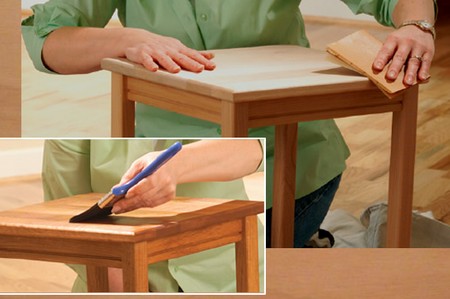If the wood itself is not damaged beyond the scope of a filler or stopper, but the finish has generally deteriorated, there are numerous remedies.
For localized problems like shallow scratches, try furniture polish, shoe polish, or even the kernel of a nut to wet, darken and blend the lighter area. Often it is only a matter of colour, and ordinary wax crayons work very well in small amounts. You can get different colours by mixing and melting shavings. The more specialized wax and shellac sticks are good for deep blemishes, even those that have gone right through to the wood. They have to be heated on a hot knife-blade -preferably curved – and dripped into the scar, then smoothed over while they are still warm, but left proud of the surface and sanded back when hard. Paint in grain lines before the finish coat. Do not hold these sticks in the flame – they are highly flammable.

White rings or spots, an overall ‘bloom’, or a smoky blue haze are common results of damp in or on french polish and cellulose. If a general bloom does not disappear when wiped (hard) with white spirit, camphor oil and tobacco ash, or meths, then it is likely that the damp is under the finish, which will have to be stripped. Be careful with meths – if your rag is too damp you will dissolve shellac. The smoky blue effect is usually the result of wax or oil being rejected by a silicone polish beneath; upper and lower layers are usually easily dealt with by white spirit.
The way to deal with the white rings or blushes that have been caused by cups and glasses, or other damp from on top, is friction. Start with the finest abrasive, even ‘extra bright’ toothpaste, and get progressively stronger if you get no result. Abrasive car polish, rottenstone or pumice powder mixed with mineral oil and rubbed on with a felt pad, salt with oil, salt with vinegar and fine steel wool and oil all abrade, and some have a chemical action as well. If you rub patiently, after a while the finish will be re-fused by the friction.
Buff the area, which will now be much duller, with a soft cloth, and apply wax or oil, unless you intend to renew the whole finish.